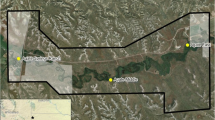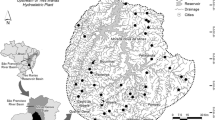Abstract
A resampling technique (bootstrapping) was used to evaluate the effects of increasing sample number on the confidence limits of mean density and the mean number of taxa (Families) in addition to the performance of four different sampling devices used to collect macroinvertebrates in three streams of contrasting anthropogenic impact. The four sampling devices were a Hess sampler, a modified Hess sampler equipped with an internal water pump, a Surber sampler, and a two-pole kick-net. In general, confidence limits decreased predictably as the number of samples increased, most notably with the addition of a third sample. The density of organisms captured with the Surber sampler was significantly lower than that of the Hess sampler but greater than that of the kick-net sampler. No significant difference in the number of Families was found among sampling devices. Based upon a minimal 10% reduction in confidence limits compared to the previous sample, a minimum of four replicates was suggested when using the Surber sampler. In general, other methods required a greater number of replicates that the Surber to adequately represent density, but this did not hold when applied to the number of taxa. Despite the inconvenience of having to bend down to use the Surber sampler, this study found no evidence to reject its apparent popularity as a sampling method for macroinvertebrates.
Similar content being viewed by others

References
Arseneau, E. R. (2002). The Petitcodiac River watershed preliminary water classification report. Petitcodiac Watershed MonitoringGroup. New Brunswick Legislative Library, (628.16/A781/ NB Coll).
Barbour, M. T., Gerritsen, J., Snyder, B. D., & Stribling, J. B. (1999). Rapid bioassessment protocols for use in streams and wadeable rivers: Periphyton, benthic macroinvertebrates and fish, EPA 841-B-99-002 (2nd ed.). Washington, DC: US Environmental Protection Agency, Office of Water Retrieved December 18, 2007, from http://www.epa.gov/owow/monitoring/rbp.
Cao, Y., Williams, W. P., & Bark, A. W. (1997). Effects of sample size (replicate number) on similarity measures in river benthic Aufwuchs community analysis. Water Environment Research, 69, 107–114.
Culp, J. M., Cash, K. J., & Halliwell, D. B. (1997). Volunteer-based monitoring program for the Salmon River Basin: using benthic indicators to assess stream ecosystem health. DOE FRAP, 1997-09. Vancouver, BC: Fraser River Action Plan Retrieved June 15, 2007, from http://www.rem.sfu.ca/FRAP/9709.pdf.
Efron, B., & Tibshirani, R. (1993). An introduction to the bootstrap. New York: Chapman and Hall.
Merritt, R. W., & Cummins, K. W. (Eds.) (1996). In An introduction to the aquatic insects of North America(3rd ed.). Dubuque, IO: Kendall/Hunt.
Resh, V. H., & McElravy, E. P. (1993). Contemporary quantitative approaches to biomonitoring using benthic macroinvertebrates. In D. M. Rosenberg, & V. H. Resh (Eds.) Freshwater biomonitoring and benthic macroinvertebrates (pp. 159–194). New York: Chapman and Hall.
Reynoldson, T. B., Logan, C., Pascoe, T., & Thompson, S. P. (2007). CABIN (Canadian Aquatic Biomonitoring Network) invertebrate biomonitoring field and laboratory manual. CanadaNational Water Research Institute, Environment CanadaRetrieved December 18, 2007, from http://cabin.cciw.ca/Application/Downloads/cabin_protocol.doc.
Storey, A. W., Edward, D. H. D., & Gazey, P. (1991). Surber and kick sampling: a comparison for the assessment of macroinvertebrate community structure in streams of south-western Australia. Hydrobiologia, 211, 111–121.
Taylor, B. R. (1997). Optimization of field and laboratory methods for benthic invertebrate biomonitoring. Report for the Canada Centre for Mineral and Energy Technology. Retrieved June 15, 2007, from http://www.nrcan-rncan.gc.ca/mms/canmet-mtb/mmsl-lmsm/enviro/reports/2.1.2finalreport.pdf .
Westcott, F. (1999). Benthic macroinvertebrates in Twin Bays and Boulder Creeks: Species Identification and community interpretation. Report prepared for the province of British Columbia Ministry of the Environment. British Columbia. Canada: Ministry of Environment, Lands and Parks (Kootney Region).
Zar, J. H. (1999). Biostatical analysis (4th ed.). Eaglewood Cliffs, NJ: Prentice Hall.
Author information
Authors and Affiliations
Corresponding author
Rights and permissions
About this article
Cite this article
Chiasson, A. Bootstrapping to investigate the effect of number of macroinvertebrate samples on confidence limits of the mean. Environ Monit Assess 149, 53–59 (2009). https://doi.org/10.1007/s10661-008-0182-0
Received:
Accepted:
Published:
Issue Date:
DOI: https://doi.org/10.1007/s10661-008-0182-0



